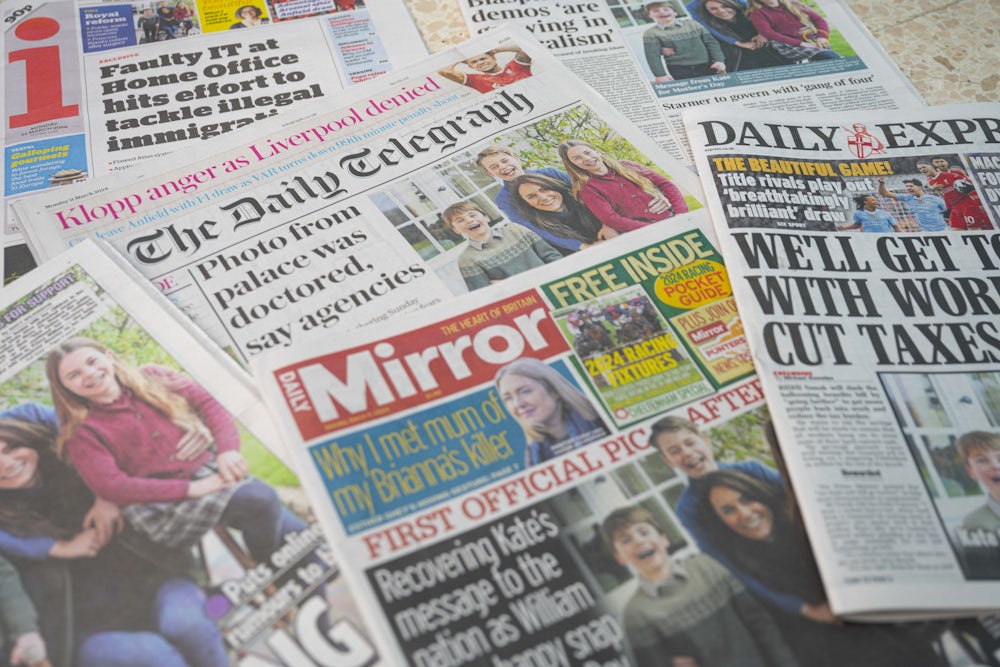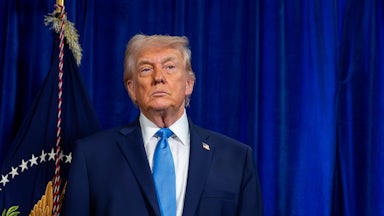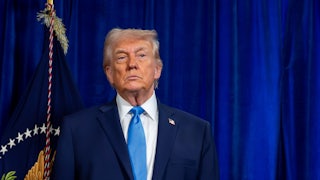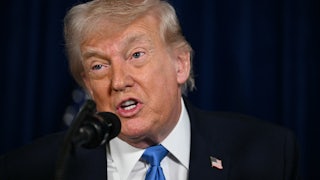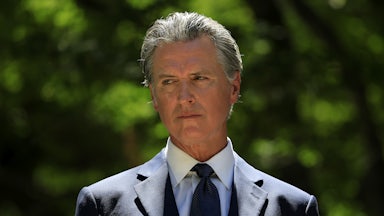Something strange is happening in the United Kingdom. Catherine, the princess of Wales—formerly Kate Middleton—has disappeared from the public eye since having unknown surgery in January. Her long convalescence has sparked public concern about her health, as well as more fanciful conspiracy theories. And Kensington Palace has utterly failed at its attempts to dispel rumors and concerns.
In the latest misstep, the palace released a photo over the weekend attributed to Kate’s husband, William, who is next in line for the throne. The picture, which shows Kate embracing their three children, was apparently designed to calm the speculation about her absence. It could not have backfired more. Internet sleuths noted that the photo appeared to be doctored—Kate’s rings are missing from her left hand, one of her kids’ clothes don’t line up properly with her arm, and so on.
The Associated Press, Reuters, and other photojournalism services issued a rare “kill order” for the handout on Sunday, effectively telling other news outlets that they could not guarantee its authenticity. The palace admitted the editing on Monday morning. “Like many amateur photographers, I do occasionally experiment with editing,” it said in a statement attributed to Kate. “I wanted to express my apologies for any confusion the family photograph we shared yesterday caused. I hope everyone celebrating had a very happy Mother’s Day.”
That the British royal family can’t seem to explain what’s happening here is extremely odd. But it also does not bode well for its long-term future. The Windsors have historically been skilled at cultivating their public image and a certain air of mystique. Elizabeth II, who died two years ago, once famously said, “I have to be seen to be believed.” The current generation’s seeming inability to maintain that standard is more than just a mere tabloid scandal: It could affect how Britain and more than a dozen other countries are governed.
The timeline of events surrounding Kate’s vanishing speaks for itself. She made her last public appearance on Christmas when she attended a church service with the rest of the royals near Sandringham Castle, one of Britain’s royal residences. Twenty-three days later, on January 17, the Waleses’ office announced that Kate would be undergoing “abdominal surgery” at a London hospital and would be staying there for 10 days. Kensington Palace did not say why she was having surgery, except to note that it was “planned” and that her illness was “not cancerous.”
“The Princess of Wales appreciates the interest this statement will generate,” the palace cryptically said in its statement. “She hopes that the public will understand her desire to maintain as much normality for her children as possible; and her wish that her personal medical information remains private. Kensington Palace will, therefore, only provide updates on Her Royal Highness’ progress when there is significant new information to share.”
While that statement aroused some curiosity at the time, it was overshadowed by Buckingham Palace’s announcement later that day that Charles would be undergoing surgical treatment for an enlarged prostate. His health drew even more interest when the palace announced on February 5 that surgeons had discovered an unspecified form of cancer during the procedure and that the 75-year-old king had begun treatment for it.
Since then, Charles has appeared at multiple public events, starting with a church attendance on February 11. But Kate, who was discharged from the hospital on January 29, remained hidden from the public eye. Curiosity grew after the army listed her as attending an annual ceremonial military parade in June, then deleted the claim after the palace said it had not actually confirmed her appearance. A grainy TMZ paparazzi photo on February 5 marked her first public sighting since Christmas but did little to answer other questions.
The British press has been largely mum on the whole thing until now, which is unsurprising and traditional. When Charles’s great-uncle Edward VIII dated a divorced American named Wallis Simpson in the 1930s, British newspapers ignored the brewing scandal for as long as they could while their American counterparts, freed from social mores and a culture of deference, extensively covered it. But the British royals’ relationship with their national media is adversarial at other times: Prince Harry in 2022 alleged that his family’s courtiers planted negative stories about his wife, Meghan, to spare other royals from hostile coverage.
While the British royals tend to be covered like celebrities, they are not like their counterparts in Europe. Of the 10 hereditary monarchies still reigning in Europe, most have converted themselves into wholly powerless figureheads. When Carl XVI Gustaf took the Swedish throne in 1974, the Riksdag formally stripped the king of even most of his ceremonial powers. Willem-Alexander, the king of the Netherlands, revealed in 2017 that he has a part-time job as a commercial KLM pilot. The princes of Liechtenstein and Monaco still retain significant day-to-day power, but only over a few tens of thousands of people each.
But the British monarchy stands out for two reasons. First, Charles III is far from a figurehead monarch. For thousands of Britons, his name is on both their passports and their rent checks. The king’s personal fief, the Duchy of Lancaster, brought in $34 million in revenue last year, much of it from rental properties. Charles proved himself to be a skilled landlord during his decades as heir apparent: When his son William took over the Duchy of Cornwall, the heir’s traditional fief, its estimated value of $1.5 billion was much greater than that of the Lancaster duchy.
It’s true that no British monarch has vetoed an act of Parliament since 1708, when Queen Anne rejected a Scottish militia bill. British monarchs no longer dismiss and appoint prime ministers based on their personal whims. But the palace still plays a quiet but influential role in shaping proposed legislation to suit its needs. The Guardian has detailed how Buckingham Palace used a procedure known as “king’s assent” to influence legislation that would affect the royals and their financial holdings, often to obscure it from public view or exempt it from regulation.
Second, and perhaps more importantly, British kings and queens are not just British kings and queens. They also reign in 14 other countries beyond the United Kingdom. These are the last vestiges of the British Empire: Australia, Belize, Canada, Jamaica, New Zealand, and so on. A great many other former British colonies are bound together in the Commonwealth of Nations, a diplomatic organization that serves as a voluntary successor of sorts to London’s former imperium. Charles, like his mother before him, bears the deliberately boring title of “head of the Commonwealth.”
Elizabeth II oversaw the initial wave of decolonization but remained generally popular in many of her remaining realms up until her death in 2022. Even then, there were signs of fracturing. Australia narrowly defeated a republicanism referendum in 1999—not necessarily because of a strong monarchist sentiment there, but because Australians did not agree on what should replace it. Barbados’s ties to the crown frayed over the years until the country voted to become a republic in 2022. Republican movements are afoot in other Caribbean countries as well, as reflected by a poorly received tour by William and Kate for his grandmother’s platinum jubilee that year.
Britain’s monarchy is not in immediate danger in most of the countries where it reigns, of course. But the esteem it once held in the second Elizabethan era is fading fast. A survey ahead of Charles’s coronation last year found that 45 percent of Britons said the monarchy should be abolished or wasn’t relevant—a 10-point jump from the same poll for his mother’s jubilee the previous year. And unlike with Britain’s ailing Tory government, which is in even more dire straits, there is no chance for new leadership on the horizon after Charles and William. If William lives to at least the same age as his father is now, he would be on Britain’s throne until the end of the 2050s.
Monarchy is an inherently weird thing in the modern age. To maintain it in a democratic state—especially in the form of Britain’s monarchy—requires talent, skill, and an eye for media management. Elizabeth so excelled at it that she was a generally popular figure even in foreign republics. Charles survived the high-profile dissolution of his marriage in the 1990s and his remarriage to his former mistress in the 2000s to become a reasonably well-liked king. The problem with hereditary rule, however, is that sometimes the kids don’t have what it takes.
